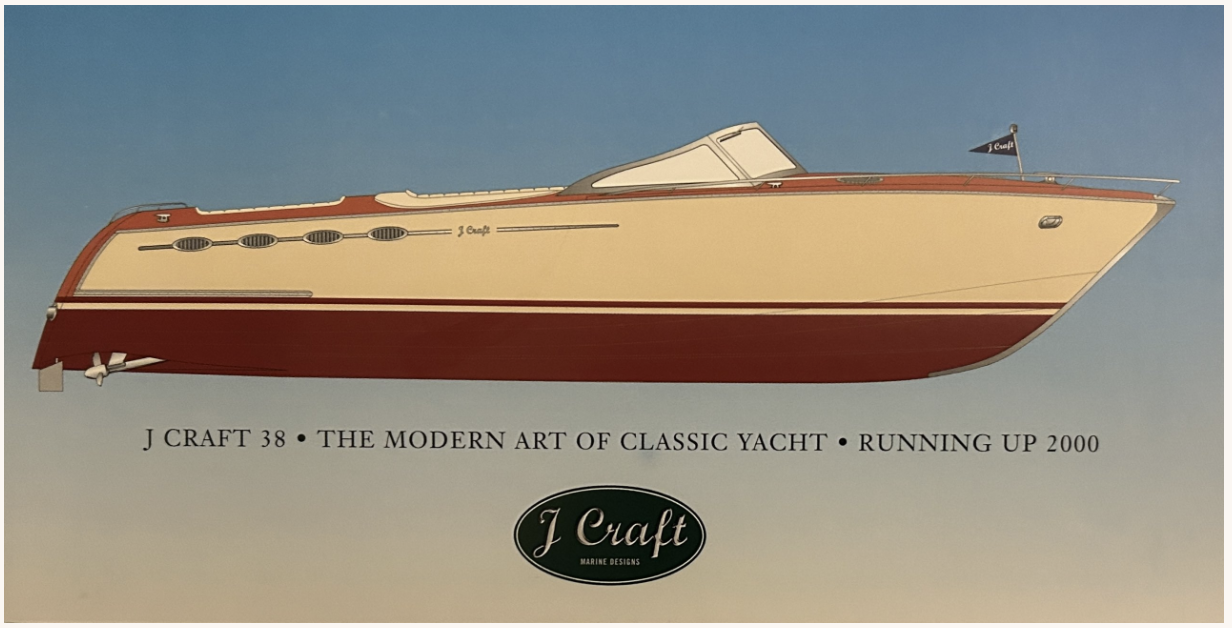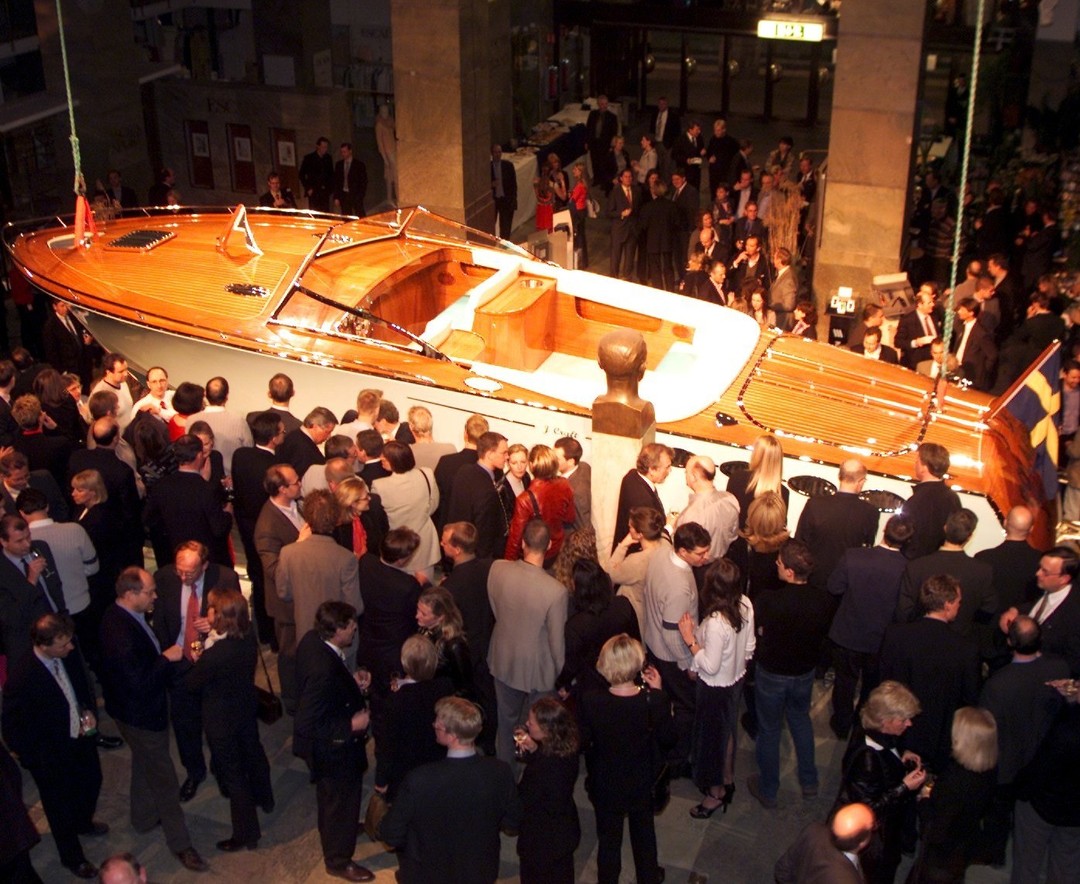Journal #4
J Craft: The Origins
From a visionary’s fantasy to a royal seal of approval, author and journalist Robert Ryan uncovers the story of how J Craft was born
Words by: Robert Ryan

In Hollywood they would call it an Origin Story. It involved a man with a dream – someone whom other people might consider a fantasist at best, a crackpot at worst – who, against a ticking clock and all the odds, sees his hopes and goals realised before time runs out on him. But this is no superhero tale. Our protagonist (and the “J” in J Craft) is Björn Janson – a successful restaurateur and entrepreneur with businesses in Visby on Gotland and in Åre, the Swedish ski resort – who had a vision of a classic wooden motorboat echoing the aesthetic of those of the ’50s and ’60s, built in Gotland, that would somehow straddle two worlds.
The first world to conquer was the home territory of wooden speedboats – the glamour spots of the French Riviera, the Caribbean, Miami, the Italian Lakes, the canals of Venice. Think Brigitte Bardot, Sean Connery, Peter Sellers, Prince Rainier of Monaco, King Hussein of Jordan, Carlo Ponti, Richard Burton and Sophia Loren, all of whom owned or loved them. There are famous photographs of Tony Curtis and his then wife Janet Leigh cruising around while on vacation and his co-star in Some Like it Hot, Marilyn Monroe, would enjoy a classic mahogany day boat (albeit wearing a very non-boating combo of diamonds and furs as she did so) while on set. The appeal of these shiny, beautiful craft is timeless – they still turn heads and they still seduce celebrities: Monica Bellucci and Justin Timberlake have been spotted in classic motorboats at the Cannes Film Festival and George Clooney’s penchant for roaring around Lakes Iseo and Como in several models has been well documented.

Björn Janson, though, wasn’t just interested in duplicating what was already on the market. He wanted the grace and elegance and head-spinning looks, but he was Swedish and based on the island of Gotland, in the middle of the Baltic Sea, where the weather isn’t always as benign as it is on northern Italy’s lakes. His concept was the boating equivalent of a steel hand in a velvet glove. The latter would be provided by the elegant lines and varnished veneers of his boat, but the hard core would draw upon the local Viking heritage of vessels that could cope with the capricious Baltic weather and perilous sea. For that, he needed a hull made from glass reinforced plastic (GRP). He also needed some advice. In movies, every dreamer needs a mentor or a sidekick. Enter Johan Hallén.
Today, Johan Hallén, now 60 (‘But I feel 30’), is chief technical officer of J Craft, but back before it was even a company, he was a key element in the realisation of Björn Janson’s dream. He also has a long-lasting connection to the sea, having renovated his first small wooden boat at the age of 16, which he used to fish cod. He subsequently did military service as a naval “mine” diver and then rose to the rank of Ship Commander Class VII. After the navy he was employed by boat builder Nimbus on Gotland. There he spent time alongside boat designer Pelle Petterson – the man who created the gorgeous Volvo P1800 (known as The Saint’s car from the days when Roger Moore drove a white one on TV). Johan also raced sailboats in his spare time. There might well be saltwater running through his veins.
‘When I first met Björn,’ Johan explains, ‘I was employed full-time in the development department of the leisure boat company Nimbus, at its Gotland facility. At the time, I also worked part-time at Björn’s restaurant business. He was sitting in the office in the evenings making a one-metre model of a Riva Aquarama in wood. This was something of a challenge for him, as he was struggling with the Parkinson’s disease that had been diagnosed some years earlier.’ This was the ticking clock, as Björn Janson’s health was slowly deteriorating. But perhaps that knowledge gave him the drive and focus to push on through with his project.
‘He knew that I worked for Nimbus,’ continues Johan, ‘so he used every opportunity to ask me literally hundreds of questions regarding the creation of a new boat in GRP.’ Did Johan think Björn Janson was living a fantasy? ‘Björn was a dreamer in the sense that nothing was impossible, and he was very creative when he had decided to realise an idea. I knew him too well to dismiss his ambitions!’
It is no secret that building a boat – in fact, being involved with seafaring craft in any capacity – can be a very expensive business.
‘I took him to Nimbus and explained to him that to justify the cost of building moulds, that instead of making just one boat, he must build at least five boats in a series. Within 10 days after his visit to Nimbus he came rushing into the office and screamed: “I have sold five boats. Now we can start the project.” By the end of 1999, the new shipbuilders had 35 full-time employees at facilities in and around Visby, Gotland.’
Every narrative needs a stroke of luck, a twist of fate or a deus ex machina plot device. This was provided by Björn Janson’s wife, who at the time worked for someone who had a very close personal connection to the Royal Swedish Household. Through this connection, Björn had the opportunity to show and explain his vision of a beautiful gem of a dayboat, with real range and built with Swedish robustness, to the royal family, as King Carl XVI Gustaf was and is a keen sailor. The king agreed to buy the first 38” J Craft Cabrio Cruiser (as the inaugural series were known). In spring 2000 the royal couple made a private visit to J Craft’s Gotland shipyard to check on its progress. ‘It was a very nice tour,’ says Johan. ‘The king spent over two-and-a-half hours there. He was very interested in the technology and spent most of the time in the engine bay. After the visit, the King and Queen Silvia tested our prototype boat.’ The king had to have some vision of his own, because, as Johan explains: ‘The test boat that we used was a very simple creation with old seats from a school bus and sand sacks as ballast to give the boat the right balance.’
Within months, the first production Cabrio Cruiser – minus the sandbags and now with some rather lovely seats – was delivered to the king. She was suspended from the ceiling of the famous Nordiska Kompaniet department store. At a naming party for specially invited guests, the king christened his new boat Polaris. He must have been happy with it, because he still owns Polaris. Today, she is based on the French Riviera, J Craft still maintains her and the king himself drives his J Craft when on holiday some 23 years later and counting.

Having royal patronage was a welcome boost for the J Craft brand and it became fêted for its superb build quality, its striking looks and its hidden robustness, a capable beauty that was as at home in the Baltic as Bimini or Bellagio.
Fast forward to 2007 and a financier, Radenko Milakovic and his wife Kristina decided to charter a Cabrio Cruiser that was being used to promote the brand in one of its natural environments – Monaco. Intending to rent it for the week, the couple went on to keep it for the entire season. As Johan puts it: ‘Both Radenko and Kristina fell in love with the immaculate style and craftsmanship the boat represented.’
Radenko might have lost his heart, but he wasn’t blind to his new love’s flaws. He said: ‘The boat had very small rudders. Turning was difficult until she picked up some speed. I eventually got used to it, but there were quite a few hairy moments when I was thinking, “Hmm, this isn't quite good enough”.’
When Radenko enquired about buying his own J Craft, with some (significant) steering/propulsion modifications, he was told this was going to be difficult, because Björn Janson’s declining health meant that the shipyard was not able to introduce these, but rather only able to deliver a standard specification Cabrio Cruiser. What happened next was another twist in the story.
Unable to acquire a Cabrio Cruiser with his desired changes, in 2007, Radenko decided to acquire J Craft itself, becoming the “steward”, as he likes to describe it, of the brand. Determined to improve on the Cabrio Cruiser (to ‘make it a 21st-century boat’) Radenko not only inspired the creation of the immensely capable 42ft J Craft Torpedo, he also blew some life into the company in the form of some badly needed capital and leadership. His overarching mission: ‘We are not going to deviate from Björn Janson’s vision. We are committed to keeping his spirit and vision alive. He lives on through all of us, particularly Johan who was there in the original setting up of the enterprise along with Björn.’ Radenko’s presence ensured the continuation of a bespoke brand with big ambitions, following Björn Janson’s death in spring 2011.

Johan is sure the company is in safe hands because Radenko and Björn share certain traits: ‘They are/were emotive people and are passionate.’ Both also appreciate(d) that, as Johan puts it: ‘The devil is in the detail.’
But the exact story of how Radenko Milakovic came to own the company and how he and Johan Hallén created the sleek, “refined” (Johan’s term) 42ft Torpedo – successor to the Cabrio Cruiser and an improved version of Björn Janson’s vision that he lived long enough to experience and endorse – is, in classic Hollywood tradition, best left to a sequel.
Robert Ryan is a journalist, screenwriter and Sunday Times bestselling author.